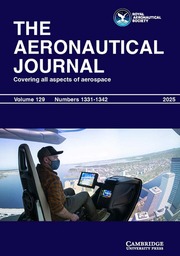Article contents
Separation control on highly-swept wingswith fixed or variable camber
Published online by Cambridge University Press: 04 July 2016
Abstract
This paper describes an experimental investigation intothe effect of miniature vortex generators (VGs) onthe longitudinal aerodynamic characteristics of ahighly-swept wing with drooped leading edges. Theexperiments were performed in a low-speed windtunnelon a wing of the same delta planform as that used ina previous study. The latter wing was of fixedcamber, while the subject of the present study was awing with three different leading edge droop angles.The maximum reduction in drag due to the VGs wasfound to be about half that for the fixed-camberwing. This is reconciled with the differentbehaviour of the flow on the upper surface for thetwo types of wing. Without control, the drag of thevariable-droop wings is much lower than that of thefixed-camber wing. As a result, with control, thevariable droop wings have lower drag than that ofthe fixed-camber wing. Compared to that of thevariable-droop wings without control, thefixed-camber wing, with control, has lowerlift-dependent drag for lift coefficients between0·4 and 0·7. However, at higher lift coefficients,the reverse applies.
Information
- Type
- Research Article
- Information
- Copyright
- Copyright © Royal Aeronautical Society 1995
References
- 8
- Cited by

